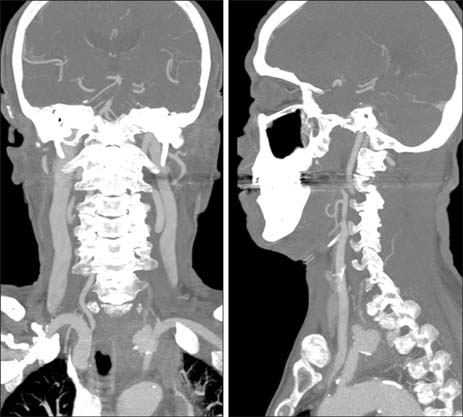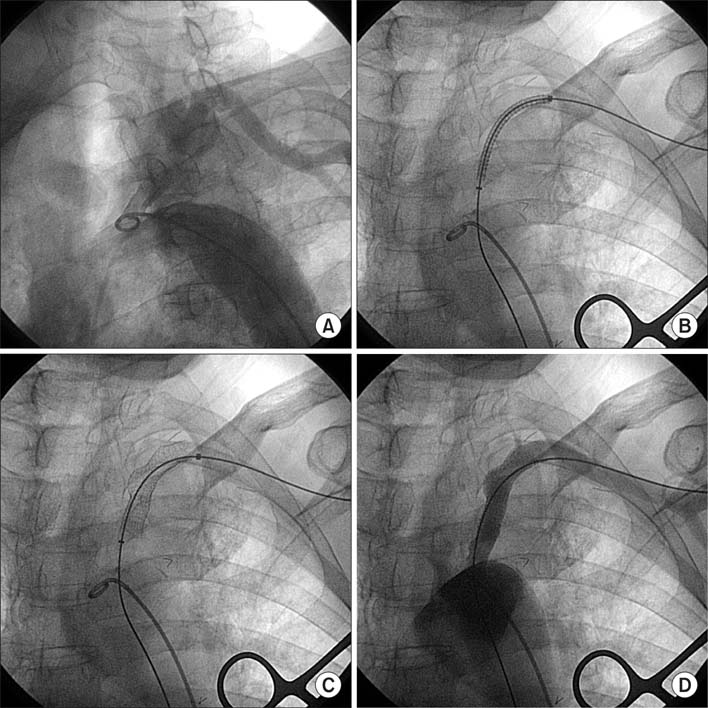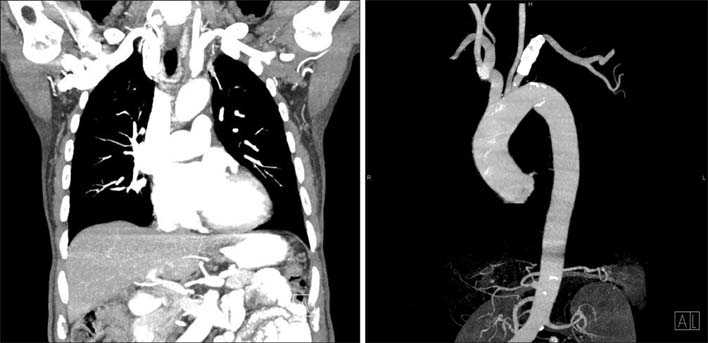Chonnam Med J.
2014 Aug;50(2):70-73. 10.4068/cmj.2014.50.2.70.
Successful Treatment of a Ruptured Subclavian Artery Aneurysm Presenting as Hemoptysis with a Covered Stent
- Affiliations
-
- 1The Heart Center of Chonnam National University Hospital, Cardiovascular Research Institute of Chonnam National University, Gwangju, Korea. myungho@chollian.net
- KMID: 2172163
- DOI: http://doi.org/10.4068/cmj.2014.50.2.70
Abstract
- An aneurysm of the subclavian artery is rare. Recently, we experienced a case of a ruptured subclavian artery aneurysm presenting as hemoptysis. The patient had experienced atypical chest discomfort, and computed tomography (CT) revealed a small aneurysm of the left subclavian artery (SCA). Hemoptysis occurred 2 weeks later. Follow-up CT showed a ruptured aneurysm at the proximal left SCA. Endovascular treatment with a graft stent was performed by bilateral arterial access with a 12-Fr introducer sheath placed via cutdown of the left axillary artery and an 8-Fr sheath in the right femoral artery. A self-expandable Viabahn covered stent measuring 13x5 mm was introduced retrogradely via the left axillary sheath and was positioned under contrast guidance with an 8-Fr JR4 guide through the femoral sheath. After the procedure, hemoptysis was not found, and the 3-month follow-up CT showed luminal patency of the left proximal SCA and considerable reduction of the hematoma.
Keyword
MeSH Terms
Figure
Reference
-
1. Dent TL, Lindenauer SM, Ernst CB, Fry WJ. Multiple arteriosclerotic arterial aneurysms. Arch Surg. 1972; 105:338–344.
Article2. Vierhout BP, Zeebregts CJ, van den Dungen JJ, Reijnen MM. Changing profiles of diagnostic and treatment options in subclavian artery aneurysms. Eur J Vasc Endovasc Surg. 2010; 40:27–34.
Article3. Chen YF, Su CS, Liu TJ, Chang MS, Jong GP, Ting CT, et al. Endovascular treatment of a nontraumatic left subclavian artery pseudoaneurysm. J Chin Med Assoc. 2012; 75:474–478.
Article4. Andersen ND, Barfield ME, Hanna JM, Shah AA, Shortell CK, McCann RL, et al. Intrathoracic subclavian artery aneurysm repair in the thoracic endovascular aortic repair era. J Vasc Surg. 2013; 57:915–925.
Article5. Halsted WS. Ligation of the first portion of the left subclavian artery and excision of a subclavian axillary aneurysm. Bull Johns Hopkins Hosp. 1892; 24:93.6. Phipp LH, Scott DJ, Kessel D, Robertson I. Subclavian stents and stent-grafts: cause for concern? J Endovasc Surg. 1999; 6:223–226.
Article7. Sitsen ME, Ho GH, Blankensteijn JD. Deformation of self-expanding stent-grafts complicating endovascular peripheral aneurysm repair. J Endovasc Surg. 1999; 6:288–292.
Article8. Kasirajan K, Matteson B, Marek JM, Langsfeld M. Covered stents for true subclavian aneurysms in patients with degenerative connective tissue disorders. J Endovasc Ther. 2003; 10:647–652.
Article9. du Toit DF, Lambrechts AV, Stark H, Warren BL. Long-term results of stent graft treatment of subclavian artery injuries: management of choice for stable patients? J Vasc Surg. 2008; 47:739–743.
Article10. Mohan IV, Stephen MS. Peripheral arterial aneurysms: open or endovascular surgery? Prog Cardiovasc Dis. 2013; 56:36–56.
Article
- Full Text Links
- Actions
-
Cited
- CITED
-
- Close
- Share
- Similar articles
-
- Successful Treatment of a Ruptured Aortic Arch Aneurysm Using a Hybrid Procedure
- Mycotic Aneurysm of the Left Subclavian Artery Presenting as Mediastinal Abscess: Case Report
- Endovascular Repair of Thoracic Aortic Aneurysm Using a Custom-made Fenestrated Stent Graft to Preserve the Left Subclavian Artery
- Emergent Endovascular Treatment of Ruptured Dissecting Aneurysm of the Intradural Vertebral Artery Using a Self-Expandable Intracranial Stent and a Bioactive Hydrophilic coil
- Bilateral Vertebral Artery Dissecting Aneurysms Presenting with Subarachnoid Hemorrhage Treated by Staged Coil Trapping and Covered Stents Graft





